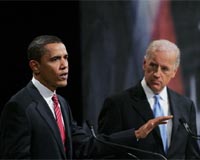 |
Beijing (AFP) June 1, 2009 China defended its economic data Monday after the International Energy Agency questioned the consistency between the nation's growth rate and its falling energy demand. Critics have said the country's growth is does not match up with its weakening oil and electricity demand. But Zhang Guobao, head of the National Energy Administration, said this was due to a change in the nation's industrial mix. "High energy consuming industry is on the decline, and low energy consuming industry is on the rise, so this has impacted electricity consumption," he told reporters. Overall electricity consumption in China from January to April dropped 4 percent compared to the same period in 2008, according to a statement released by the energy administration. In the same period, China imported 57 million tonnes of crude oil, a 4.5 percent drop from a year earlier, Zhang told reporters. But China's first quarter GDP grew by 6.1 percent. Historically, demand for oil and electricity products is used as a proxy for gross domestic product growth. The International Energy Agency in its May report on the oil market questioned the figures. "Oddly enough, (first quarter of 2009) reported GDP growth does not tally with oil demand data (nor with electricity demand, which was also inordinately weak)," it said. But Zhang pointed to slowing growth in heavy industry, which traditionally accounts for around 80 percent of industrial electricity consumption. He said the oil processing and coking industries had dropped by 5.4 percent in the first quarter, whereas communications -- a low-energy consuming sector -- had increased 15.5 percent. Zhang also said that part of the demand for steel and non-ferrous metals had recently been met by existing inventories instead of new production, which would have increased electricity consumption.
China says manufacturing continued to expand in May The official Purchasing Managers' Index, or PMI, for the manufacturing sector pulled back slightly to 53.1 in May, down from 53.5 in April, the China Federation of Logistics and Purchasing said in a statement on its website. A reading above 50 means the sector is expanding, while a reading below 50 indicates an overall decline. "We expect manufacturing activity will continue to expand in the coming months, supported by the roll-out of the government stimulus," Jing Ulrich, a Hong Kong-based economist with JP Morgan, said in a research note. Beijing announced a four-trillion-yuan (585-billion-dollar) stimulus package last year in a bid to prop up growth in the world's third largest economy by boosting spending on infrastructure and other government-backed projects. The PMI sank to a record low of 38.8 in November due to the global financial crisis, but improved continuously in the five months until April, moving above 50 in March. A separate PMI published by independent brokerage CLSA on Monday pointed to a second straight month of production growth in May, with the index standing at 51.2, up from 50.1 in April and 44.8 in March. "The index provided further evidence to suggest that operating conditions in the Chinese manufacturing sector have stabilised, and that solid growth momentum may be building," the Hong Kong-based brokerage said in a statement. Manufacturing accounts for more than 40 percent of the economy in China, which has been hit hard by evaporating demand for its products in key export markets such as the United States and Europe. Share This Article With Planet Earth
Related Links
 The Obama-Biden New Energy For America Plan
The Obama-Biden New Energy For America PlanClinton NJ (SPX) Jun 01, 2009 Diversifying energy sources is a key goal set out in the Obama-Biden New Energy for America plan. Reducing the nation's dependence on oil has been called one of the greatest challenges our nation has ever faced. Quick and bold actions were proposed to transform the entire economy, "from cars and fuels, to factories and buildings." At the same time, the plan recognizes the potential for ... read more |
|
| The content herein, unless otherwise known to be public domain, are Copyright 1995-2009 - SpaceDaily. AFP and UPI Wire Stories are copyright Agence France-Presse and United Press International. ESA Portal Reports are copyright European Space Agency. All NASA sourced material is public domain. Additional copyrights may apply in whole or part to other bona fide parties. Advertising does not imply endorsement,agreement or approval of any opinions, statements or information provided by SpaceDaily on any Web page published or hosted by SpaceDaily. Privacy Statement |